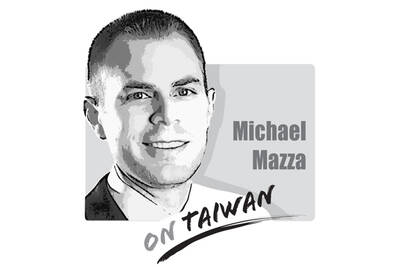The dispute over the Diaoyutai Islands (釣魚台) is not a new one. As a young man, President Ma Ying-jeou (馬英九) made his name as part of the original Protect the Diaoyutai Movement (PDM), a foot-soldier in the Chinese Nationalist Party’s (KMT) resistance against China’s efforts to secure unification with Taiwan.
The PDM now has a new manifestation, but this time China is using it as part of its efforts to promote unification. The KMT has previously sought to cover up the truth behind the Diaoyutais and this has caused misunderstandings over what the PDM is really about.
According to US diplomatic records, the original PDM was instigated by Chinese student activists in the US, who were sympathetic to the People’s Republic of China (PRC) after Japan declared sovereignty over the Diaoyutai Islands.
The goal of the movement was to unify China and break up relations between Taiwan, the US and Japan.
That Beijing claims sovereignty over the Diaoyutais galvanized the movement among pro-unification Chinese student activists in the US and Hong Kong. This forced the KMT to make its own claim of sovereignty if it was to survive.
At the time, the US ambassador in Taipei believed that, although Taiwan’s own PDM was not actively encouraged by the government, it was given tacit approval.
It was seen as useful to the anti-unification cause and also a convenient way of showing dissatisfaction at then-US president Richard Nixon’s detente with China.
The Republic of China’s (ROC) ambassador to the US at the time, Chow Shu-kai (周書楷), told the US that the PDM was part of China’s attempts to drive a wedge between Taiwan and the US and that if the KMT did not insist on sovereignty over the islands, there was a risk that Taiwanese intellectuals would “go over” to the PRC.
Chow submitted a memorandum regarding sovereignty of the Diaoyutais to the US, but later, in late 1971 in his new capacity as ROC foreign minister, he conceded to then-US National Security adviser Henry Kissinger that the KMT government had no intention of actually taking the islands.
He also said he hoped the Japanese government would refrain from making such information public because of the political problems this would cause at home.
The weakening of the PDM dissipated following Nixon’s visit to China, and Japan’s subsequent recognition of the PRC as the sole representative of China both dealt grievous blows to the KMT.
China is behind the new PDM, too, trying to use it, as it did back in the 1970s, to further unification with Taiwan and break up the First Island Chain that the US wants as a buffer against China’s power.
Now that Ma has accepted the “one China” principle, sovereignty of the Diaoyutais has become a dispute between “China” and Japan.
People who do not know the facts of the matter get hot under the collar as soon as there is talk of violations of sovereignty or territorial disputes. They throw their support behind the Diaoyutais without understanding the subtleties of the issue.
However, since Ma’s concept of the ROC includes sovereignty over all of China, why do his supporters, and particularly Taiwanese businesspeople in China, not claim sovereignty over all of Taiwan and China?
Ma is being played by the PDM. He is nothing but a pawn. This was true in the past and it is true now. If you do not know the truth behind the Diaoyutais, there is no way you can make sense of it.
James Wang is a media commentator.
Translated by Paul Cooper
The image was oddly quiet. No speeches, no flags, no dramatic announcements — just a Chinese cargo ship cutting through arctic ice and arriving in Britain in October. The Istanbul Bridge completed a journey that once existed only in theory, shaving weeks off traditional shipping routes. On paper, it was a story about efficiency. In strategic terms, it was about timing. Much like politics, arriving early matters. Especially when the route, the rules and the traffic are still undefined. For years, global politics has trained us to watch the loud moments: warships in the Taiwan Strait, sanctions announced at news conferences, leaders trading
The saga of Sarah Dzafce, the disgraced former Miss Finland, is far more significant than a mere beauty pageant controversy. It serves as a potent and painful contemporary lesson in global cultural ethics and the absolute necessity of racial respect. Her public career was instantly pulverized not by a lapse in judgement, but by a deliberate act of racial hostility, the flames of which swiftly encircled the globe. The offensive action was simple, yet profoundly provocative: a 15-second video in which Dzafce performed the infamous “slanted eyes” gesture — a crude, historically loaded caricature of East Asian features used in Western

Is a new foreign partner for Taiwan emerging in the Middle East? Last week, Taiwanese media reported that Deputy Minister of Foreign Affairs Francois Wu (吳志中) secretly visited Israel, a country with whom Taiwan has long shared unofficial relations but which has approached those relations cautiously. In the wake of China’s implicit but clear support for Hamas and Iran in the wake of the October 2023 assault on Israel, Jerusalem’s calculus may be changing. Both small countries facing literal existential threats, Israel and Taiwan have much to gain from closer ties. In his recent op-ed for the Washington Post, President William
A stabbing attack inside and near two busy Taipei MRT stations on Friday evening shocked the nation and made headlines in many foreign and local news media, as such indiscriminate attacks are rare in Taiwan. Four people died, including the 27-year-old suspect, and 11 people sustained injuries. At Taipei Main Station, the suspect threw smoke grenades near two exits and fatally stabbed one person who tried to stop him. He later made his way to Eslite Spectrum Nanxi department store near Zhongshan MRT Station, where he threw more smoke grenades and fatally stabbed a person on a scooter by the roadside.